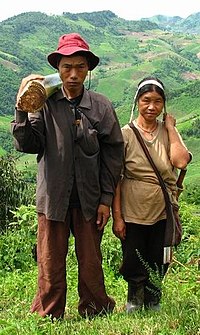
Photo from wikipedia
Abstract Following a long and vigorous study carried out by the International Committee on Anthropogenic Soils (ICOMANTH), the Soil Taxonomy (ST) classification system recently incorporated a number of changes to… Click to show full abstract
Abstract Following a long and vigorous study carried out by the International Committee on Anthropogenic Soils (ICOMANTH), the Soil Taxonomy (ST) classification system recently incorporated a number of changes to include Human-Altered and Human-Transported soils, generally called anthropogenic soils. These changes underwent careful scrutiny as they affect the current classification of existing soil series, and as the proposals and logics are as yet untested against existing data and descriptions. Particular attention was given to the diagnostic characteristics of the anthropogenic soils and to the Subgroups for Human-Altered and Human-Transported soils. In this study, we consider a frequent occurrence in many areas of Southern Italy, and particularly so in Sicily, where farmers apply pedotechniques to tailor soils to suit the growth of table grapes in order to increase income. Over the last two decades, these processes have expanded to cover >40,000 ha. In classifying these soils according to the Soil Taxonomy it became apparent that none of the new subgroups proposed by the ST fitted morpho-descriptive and analytical features. With reference to two case studies, we propose the introduction of a new ST subgroup for Human-Altered and Human-Transported soils, i.e. the “Anthroportaltic” (modified from Greek anthropos, human, and Latin portāre, to carry, and Latin alterāre, to change). The above-proposed subgroup refers to soils that are formed in 50 cm or more of human transported material (HTM). This descriptor could be used primarily for soils that are formed in human-transported material where ripping or deep ploughing has fractured, displaced and incorporated diagnostic horizons belonging to soils subsequently covered by HTM. Moreover, we stress that the use of subgroups to identify distinct groups of Human-Altered and Human-Transported soils, should be independent from soil moisture regimes. Indications on the surveyed soils are also given following the World Reference Base (WRB).
Journal Title: Catena
Year Published: 2018
Link to full text (if available)
Share on Social Media: Sign Up to like & get
recommendations!